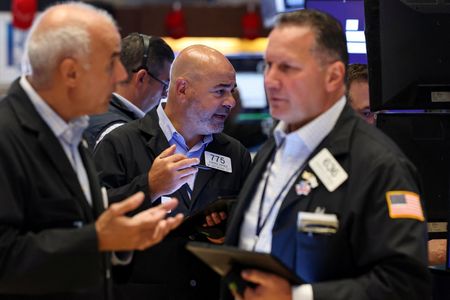By Jamie McGeever
ORLANDO, Florida (Reuters) -TRADING DAY
Making sense of the forces driving global markets
By Jamie McGeever, Markets Columnist
Stocks around the world raced to fresh highs on Tuesday, with investors betting that U.S. inflation is tame enough to pave the way for a rate cut next month, although they remain on edge over the pressure President Donald Trump continues to bear on the Fed and other public and private sector institutions.
More on that below. In my column today I look at Latin American currencies and ask whether their attractive “carry” will be enough to sustain their remarkable outperformance so far this year.
If you have more time to read, here are a few articles I recommend to help you make sense of what happened in markets today.
1. Trump weighing lawsuit against Fed’s Powell overrenovations, White House says 2. Trump rebukes Goldman’s Solomon and bank’s economicsresearch on tariff impact 3. Trump picks Heritage economist Antoni to lead U.S. laborstatistics agency 4. AI startup Perplexity makes bold $34.5 billion bid forGoogle’s Chrome browser 5. Treasuries have dozed off for the summer: Mike Dolan
Today’s Key Market Moves
* FX: Dollar weakens 0.5% as Fed rate cut bets strengthen. * STOCKS: New highs for Japan’s Nikkei 225 and TOPIX,Australia’s ASX, the S&P 500, Nasdaq and MSCI All Countrybenchmarks. Russell 2000 U.S. small caps index +3%, best daysince May. * SHARES/SECTORS: All 11 sectors in the S&P 500 rise, ledby communications +1.8%. U.S. airlines fly: United +10%, Delta+9%. Japan’s Softbank +7%, taking gains in past week to ~30%. * BONDS: Treasury yields dip 3 bps at the short end andrise up to 4 bps at the long end. Curve steepest in a month. * COMMODITIES: Oil falls, WTI futures down 1.2% towards$63/bbl. Demand and supply issues at play, traders also lookingahead to Trump-Putin meeting in Alaska on Friday.
Today’s Talking Points:
* Weakness in the long end of the U.S. bond market and steepening of the yield curve. Reasons? Unease about the apparent certainty of a rate cut next month, deepening concern over Fed credibility and independence in the face of Trump’s pressure on Chair Jerome Powell. On Powell’s potential replacements, James Bullard and Stephen Miran both stressed on Tuesday that Fed independence is of paramount importance.
* Deepening unease around Trump’s interference in the economic arena. He has intensified his verbal attacks on Powell for not cutting rates, and is considering a lawsuit against him related to renovations at the Fed’s Washington HQ. He has fired the Bureau of Labor Statistics commissioner, called for the CEO of Intel to resign, and on Tuesday hit out at Goldman Sachs’ CEO and chief economist for the bank’s analysis of the impact of tariffs.
* Another whoosh in U.S. and global equities, which lifts many benchmark indices to new highs. With Trump’s trade war on pause and the earnings season winding down, AI-related optimism and rate cut hopes are underscored by Perplexity AI’s unsolicited $34.5 billion all-cash offer for Alphabet’s Chrome browser, and July’s in-line CPI inflation report.
High-flying LatAm currencies may struggle to carry on
As U.S. President Donald Trump has upended many global economic norms this year, investors have faced several counterintuitive swings, including the dollar’s plunge and record highs in bitcoin and U.S. stocks.
Now we can add another to that list: the stellar outperformance of Latin American currencies against the dollar.
At the start of the year Mexico’s peso was thought to be particularly vulnerable to looming U.S. tariffs, and domestic fiscal concerns were expected to limit the Brazilian real’s upside.
But last week, one index tracking the region’s currencies against the greenback, MSCI’s International EM Latin America Currency Index, rose to the highest level since it was launched in 2009, bringing its year-to-date gains up to 20%.
For comparison, MSCI’s EM Asian currency index and global EM currency indexes both peaked in early July, but their year-to-date gains at that time were only around 7%. And both have eased back since.
Bank of America analysts estimate that Latin American currencies have appreciated more than 5% this year in real terms, moving from 3.2% undervalued to 2.2% over-valued versus averages over the last decade.
What accounts for this outperformance? And, perhaps more importantly, can it continue?
CARRY ON
Price was obviously one major catalyst here. Many of these currencies were simply cheap at the start of the year. The Brazilian real and Mexican peso both depreciated around 20% in calendar year 2024.
But the key factor is ‘carry’, the yield and interest rate differential relative to the U.S. dollar. In nominal and inflation-adjusted terms, the carry in Latin America is among the highest in the world, thanks to borrowing costs in Mexico and particularly Brazil.
The Brazilian central bank’s benchmark Selic rate is an eye-popping 15%, and even factoring in above-target inflation, real rates and bond yields are still close to 10%. Mexico’s central bank may have cut rates 325 basis points in the past year, but its policy rate is still more than 330 bps higher than the U.S. fed funds rate.
When you factor in the liquidity of these two currencies relative to most of their EM counterparts, you can see why foreign investors have flocked to them. The real is up 14% against the dollar this year, and the peso is up 12%. Even the Colombian peso, facing headwinds from a renewed wave of domestic political violence and uncertainty, is up 10% this year.
Citing high real carry, analysts at UBS and Barclays remain positive on emerging market currencies, including Latin America’s big two. That’s partly because the gap with U.S. rates is likely to persist, especially in Brazil, even if local rates fall, given that the Fed may soon be easing policy as well.
RETHINK
Upside potential in the second half of the year is bound to be capped, however, precisely because of the bumper gains in the first six months.
Emerging market local currency government bonds have returned 12% in dollar terms this year, while EM stocks are up 16%, outpacing hard currency bonds (+7%), U.S. corporate bonds (+5%), U.S. Treasuries (+4%), and U.S. equities (+8%), according to Bank of America.
“This strong rally is prompting many investors to reassess their exposure to EM rates and currencies,” BofA analysts wrote last week.
This exposure was highlighted in BofA’s August global fund manager survey released on Monday. The closely-watched poll showed that investors’ biggest rotation recently has been into emerging markets, with a 15 percentage point jump from the month before. Their largest overweight position now, by some distance, is in EM assets.
Significantly – and perhaps ominously from an exchange rate perspective – investors’ biggest short position is in the U.S. dollar.
And when considering headwinds, we can’t forget tariffs. While the vulnerabilities in Asian countries have been a key investor focus, Brazil is also clearly in Trump’s line or fire, as it faces 50% tariffs on many of its U.S.-bound goods. Trade talks between Brasilia and Washington have broken down completely, with President Luiz Inacio Lula da Silva saying U.S.-Brazil relations are at a 200-year low.
Mexico has more breathing room, having secured a three-month truce to safeguard the U.S.-Mexico-Canada Agreement (USMCA), stave off 30% levies, and negotiate a broader trade deal. But until the ink dries, uncertainty will persist.
The Trump 2.0 era has taken markets on a wild ride with many unexpected turns. Latin American exchange rates have enjoyed a dramatic upward climb, and while this doesn’t mean they’ll necessarily plummet, investors may want to buckle up.
What could move markets tomorrow?
* Chinese corporate earnings, including Tencent, LenovoGroup * Thailand interest rate decision * Japan tankan survey (August) * Japan producer prices (July) * U.S. Fed officials on the stump: Richmond Fed PresidentThomas Barkin, Chicago Fed President Austan Goolsbee, AtlantaFed President Raphael Bostic * Bank of Canada minutes
Want to receive Trading Day in your inbox every weekday morning? Sign up for my newsletter here.
Opinions expressed are those of the author. They do not reflect the views of Reuters News, which, under the Trust Principles, is committed to integrity, independence, and freedom from bias.
(By Jamie McGeever; Editing by Nia Williams)










